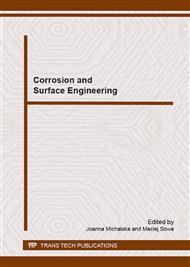p.119
p.123
p.127
p.131
p.135
p.139
p.143
p.147
p.151
Anticorrosive Property of Potassium Dichromate Film on Galvanized Coating in Distilled Water
Abstract:
Hot Dip Galvanized (HDG) coating protects steel from corrosion by providing a thick, tough metallic zinc envelope, which completely covers the steel surface and seals it from the corrosive action of its environment. The anti-corrosion ability of this sacrificial anode cathodic protection can be improved upon through the protective nature of passivation films on zinc like potassium dichromate.This study investigated the anti-corrosion effect of potassium dichromate (K2Cr2O7) film on freshly galvanized coating in distilled water (pH=7.92). The K2Cr2O7 film passivity on the hot-dip zinc coated steel sheets (taken as treated in the context of this study) was used in direct comparison with their untreated counterparts. The test was run for 30 days at 120 hours interval during which the corresponding weight losses, corrosion rates, inhibitor efficiencies, and pH of the final solutions were obtained of the coupons. Analysis of results was made using Microsoft office applications. The surface morphology of the samples was obtained using Optical microscope. The results obtained revealed the greater influence of the action of the K2Cr2O7 film on selected and examined HDG steel sheets corrosion performance. Weight losses increased with increase in immersion time. Inhibitor efficiency of 4.1% was achieved. The photomicrographs confirmed the occurrence of corrosion on untreated coating more than the treated ones. Conclusively, potassium dichromate was effective in passivating galvanized coating from white rust.
Info:
Periodical:
Pages:
135-138
Citation:
Online since:
January 2015
Price:
Сopyright:
© 2015 Trans Tech Publications Ltd. All Rights Reserved
Share:
Citation:


